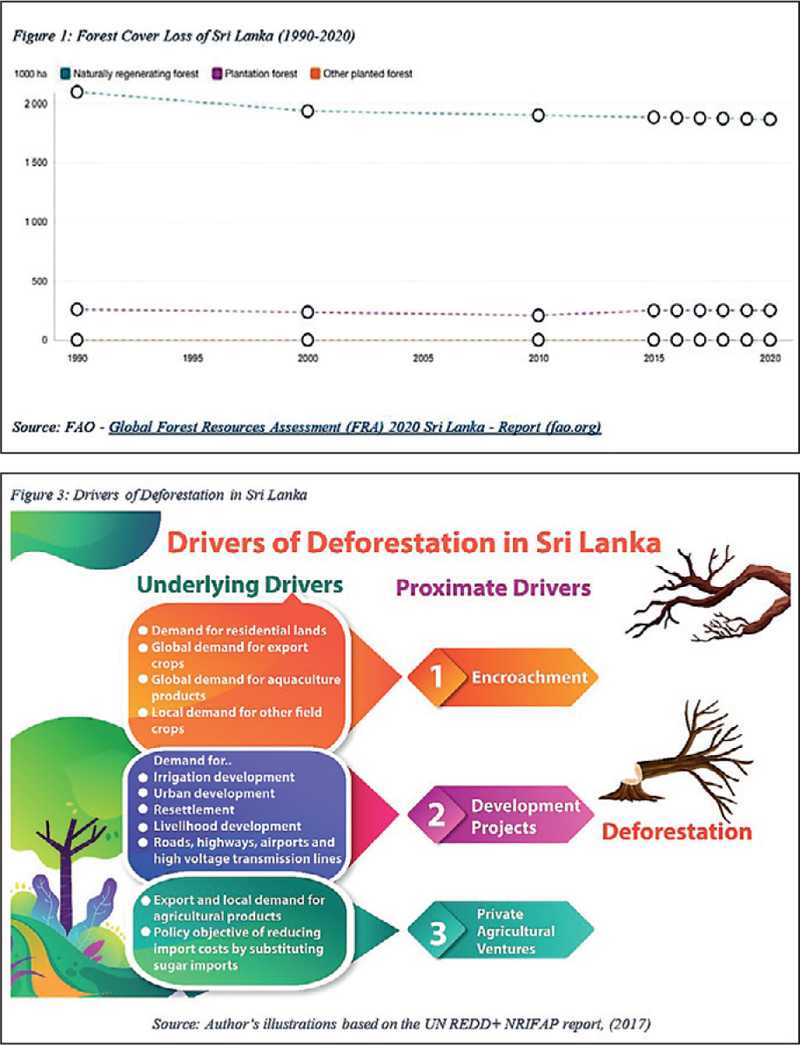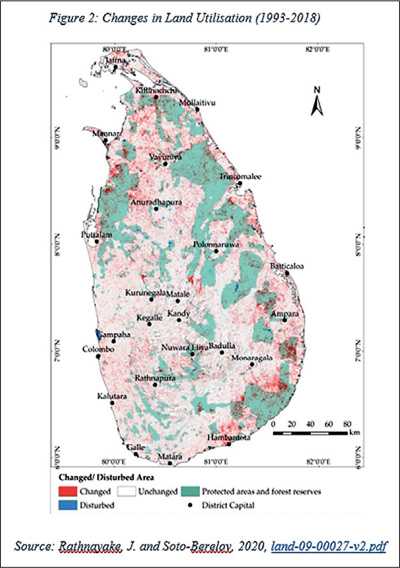Wednesday Jan 01, 2025
Wednesday Jan 01, 2025
Monday, 12 April 2021 01:03 - - {{hitsCtrl.values.hits}}

By Ruwan Samaraweera
This year, the International Day of Forests is marked under the apt theme ‘Forest restoration: a path to recovery and well-being’. Forest restoration is one of the priority areas for mitigating the effects of climate change. Restoration and sustainable management of forests will help absorb atmospheric pollutants, re-build natural habitats and sustain life on earth. This blog discusses Sri Lanka’s declining forest cover and offers suggestions on how the drivers of deforestation can be countered.
Sri Lanka’s declining forest cover
Sri Lanka is endowed with a diverse range of forest ecosystems thanks to different topographic, climatic and soil conditions. Dry monsoon forests, lowland rain forests, moist monsoon forests, montane forests, riverine dry forests, savanna and mangrove forests are the major types of forests found in the country.
However, recent technical reports and mainstream media reports both signal a rapid increase in deforestation and degradation of forests in Sri Lanka. An estimated 70% of the island was covered with forests at the beginning of the 19th century, which has since reduced to 29.7% (1.95 million hectares) in 2017. Figures from the Food and Agricultural Organization (FAO) suggest that in 2020, the forest cover has further reduced to 28.39% (1.86 million hectares) of the entire land area (Figure 1).
An estimated -3.16% change in forest area has been observed during the period from 2015-2020. Primary forests are the most affected forest types. In 1999, the island had been covered by 257,000 hectares of primary forests whereas in 2020, only 167,000 hectares remained. A new study conducted by Rathnayake, J. and Soto-Berelov (2020) which employs satellite data analysis confirms the disturbances to the protected areas (see Figure 2). Red dots on the protected areas provide evidence of deforestation taking place within the protected areas.
 Drivers of deforestation
Drivers of deforestation
A detailed account of the drivers of deforestation in Sri Lanka is published in a report under the UN-REDD program in 2015. The report identifies the catalysts of deforestation from past, present and future perspectives. Most of the drivers are socio-economic in nature.
In the current context, land encroachment, development projects and expansion of private agricultural ventures are the main proximate drivers of deforestation. People encroach protected areas for agricultural and mining activities. With population growth, local demand for land and field crops as well as global demand for export crops and aquaculture products (,shrimps etc.) rise. Hence, people who are pressurised by these drivers along with severe land scarcity, encroach into protected areas.
On the other hand, government policy objectives to increase local agricultural production and reduce agricultural imports such as sugar and milk also lead to an expansion of agricultural ventures. Besides, demand for precious stones like gems accelerates the degradation of forests through encroachment for mining activities. Infrastructure development is another driver of deforestation and degradation of forests.
Examples are projects on urban development, resettlements, tourism, livelihood development, infrastructure development like roads, highways and airports and voltage transmission lines. Moreover, local demand for timber from both households and industry contributes to the illicit felling of trees.
The way forward
Strengthening environmental safeguard measures: The incoherence in existing policies on forest conservation along with new initiatives to expand agricultural production or other development projects can encourage encroachments and deforestation. For instance, in 2020, Sri Lanka cancelled three circulars that protected 700,000 hectares of forests recognised as other State forests.
These areas are not classified as protected areas, yet account for 5% of the remaining forest cover. At present, protected areas are being managed by two agencies with limited integration―the Forest Department and Department of Wildlife Conservation with different official mandates, yet required to combine efforts to protect forest areas and their biodiversity. Therefore, the government should take necessary action to strengthen environmental safeguards associated with development programs and carry out monitoring activities.
Awareness creation: Awareness creation can be an effective initiative with long-lasting impacts on forest restoration and conservation. On many occasions, people do not recognise the importance of multiple ecosystem services offered by protected areas and push for harnessing short-term economic benefits alone. Thus, greater awareness initiated by both private and public entities would ensure a sustainable use of forest lands through restoration and reduced disturbances.
Participatory approach: Public, private and community partnerships are essential for sustainably managing protected areas. Private ventures can adhere to minimal deforestation policies or implement offset policies such as replanting. Communities can initiate partnerships with public and private authorities to carry out replanting programs. Such programs can be further developed as social ventures like the Smallholder Farmers Alliance (SFA), a non-profit social venture in Haiti, which planted five million trees to offset the severe deforestation rates in the country.
Reforestation: Replanting endangered and endogenous species in degraded natural forests and private lands would support the reforestation efforts.
Promote substitutes for timber: Substitutes for timber such as aluminium, steel and processed wood from sources like bamboo should be promoted. However, these substitutes should not harm the environment.
Innovative agriculture: Development of agroforestry models, increased tree cover of non-forest lands and sustainable management of plantations would minimise the pressure on forest lands. These interventions would ensure the sustainable utilisation of forest ecosystems supporting the reforestation efforts as well.
(Link to original blog on Talking Economics: https://www.ips.lk/talkingeconomics/2021/03/22/forest-restoration-where-does-sri-lanka-stand/)
(Ruwan Samaraweera is a Research Officer at IPS, with a background in entrepreneurial agriculture. He holds a Bachelor’s in Export Agriculture from Uva Wellassa University of Sri Lanka. His research interests are in environmental economics, agricultural economics, macro-economic policy and planning, labour and migration, and poverty and development policy. Talk to Ruwan – [email protected])